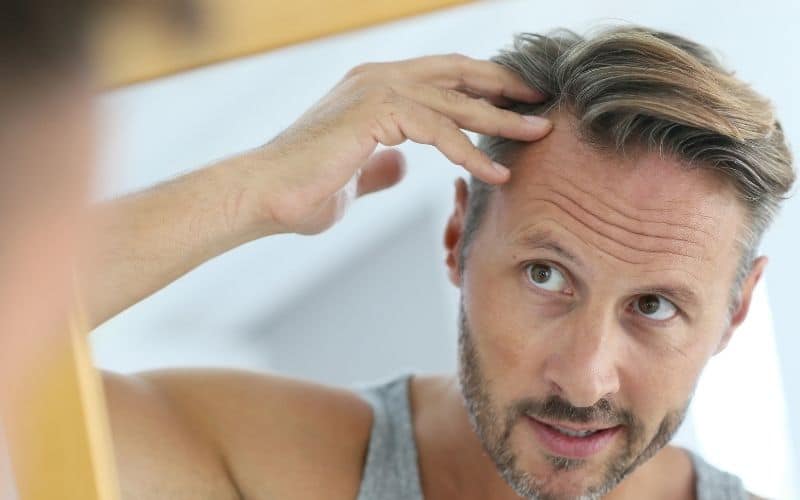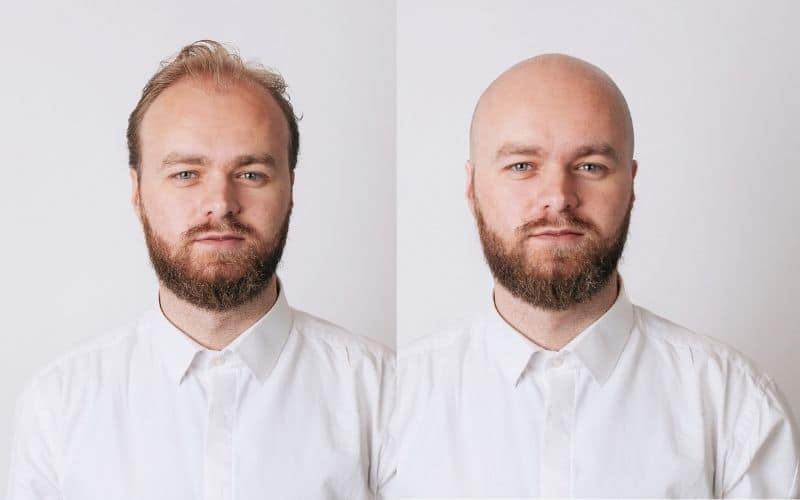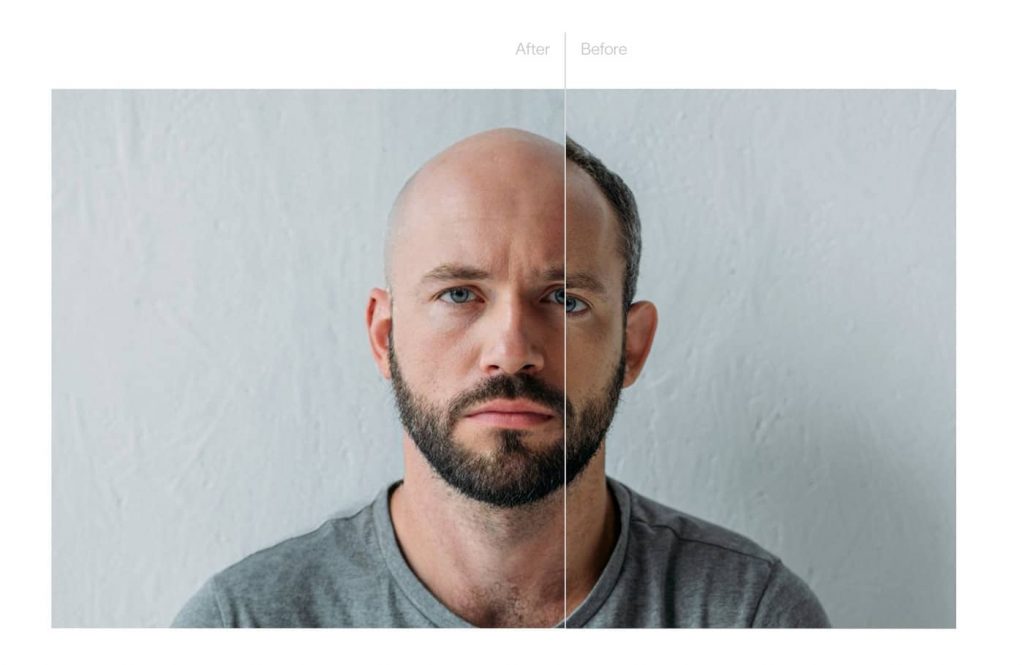So you’ve finally gotten around to cleaning your shower, and found a big ball of hair in the drain? Or your towel seems to be made of fur after every time you dried your hair? Or maybe you’re simply noticing a growing forehead or a bald patch on your head somewhere?
The good news is that hair loss is completely normal, and part of the biological cycle of every human. Having said that, not all hair loss is the same, so let’s have a look at what’s considered normal.

Types of hair loss
Broadly speaking, there are three types of hair loss for men.
The first one is what’s considered normal hair loss, and is part of the different stages of hair growth: Anagen (the growing phase), Catagen (the transition phase), Telogen (the resting phase), and Exogen (the shedding phase). In this last phase, the follicles essentially release old hairs to make space for new hairs and start the cycle over again. Old hair is replaced by new hair, which spells hair loss.
The second type is what typically concerns guys: Androgenetic Alopecia, or Male Pattern Baldness. A variety of causes can lead to Male Pattern Baldness, and anywhere from 50% to 90% of men will experience some form of it over the course of their life. Typical initial symptoms include a receding hairline and a thinning crown.
The third and rarest case is hair loss based on a medical condition, or on any other internal or external reason outside of the ones mentioned above. One example is Alopecia Areata, a condition in which the body’s own immune system attacks hair follicles, causing them to release hairs. Another rare condition is called Telogen Effluvium, in which a sudden increase in stress pushes a disproportionately large number of hairs into the resting phase (Telogen). This eventually leads to a “backlog” and subsequent hair loss.
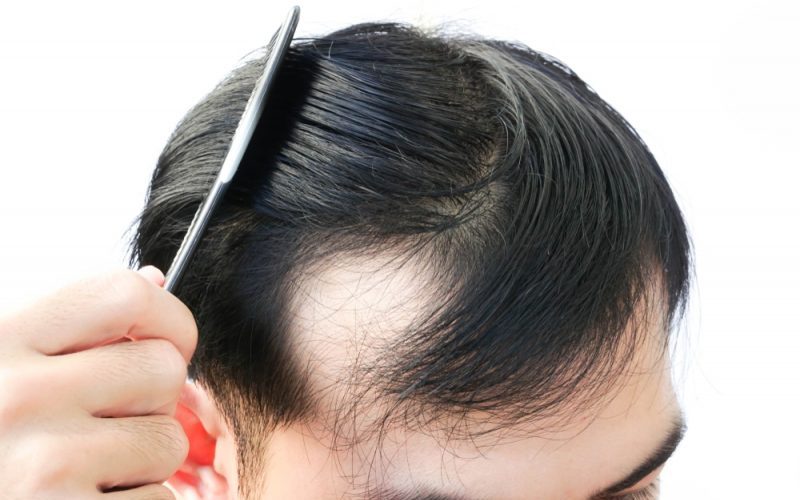
How to tell if you’re losing too much hair
If the above selection sounds complicated – don’t worry. It’s pretty easy to tell which one you are affected by, by both how and where the hair loss is as well as the amount of hair you’re losing.
How much hair loss is normal per day?
Normal, stage-related hair loss affects pretty much everyone. It occurs evenly distributed all over your head, including your beard. The average person loses anywhere between 50 and 100 hairs every day, and anything up to even 250 hairs a day is no reason to worry. If you’re simply seeing some hair in your brush or shower, or on your towel and can’t spot a specific balding patch anywhere – that’s normal.
How much hair is supposed to fall out in the shower for women?
This measurement really depends on the thickness and length of hair. People with shorter and thinner hair tend to shed less hair and subsequently, people with long and/or thick hair will shed more.
Women with thick and long hair who only wash their hair once or twice a week will notice a significant amount of hair loss due to a backlog of build up. This could be up to 250 hair strands. Considering the average person has 250,000 hairs on their head, this number shouldn’t alarm you.
Now, it’s obviously not likely you will sit there and count every strand trickling down the drain, but here are some examples.
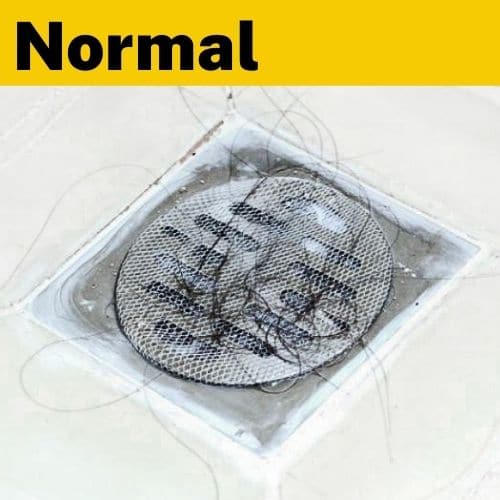
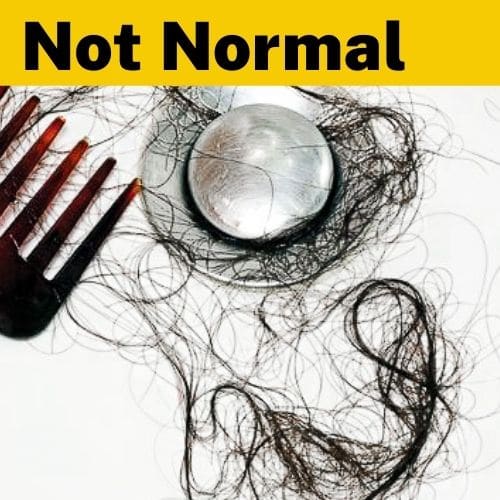
If your drain looks like the image on the left, that is pretty average for natural hair loss. A little more than this is okay too. But if your drain is consistently looking like the picture on the right, it might be best to check in with your doctor.
How much hair loss is normal in the shower for men?
Men will lose between 50-100 strands of hair a day on average but can be more depending on your hairs thickness and length.
If you are experiencing small & even amounts of hair loss across your whole head then it may not be a cause for concern. But if you are noticing hair loss and thinning in specific patches, this could be down to MPB.
There are a few ways to check if the amount of hair you are losing is normal. See the 60 second hair count instructions below.
Methods to test how much hair you are losing:
Tug hairs: grab a group of roughly 50-70 hairs. Tug at them lightly. If more than 3 strands of hair come loose, then that would be more than normal.
Check your pillow: see if you’re pillow is covered with more strands than usual of a morning.
Brushing: brushing your hair is another activity that causes a lot of hairs to fall. A lot of the time though, especially in women, hair falling can be due to hair breakage on the lengths of the strands as opposed to hair loss from the root. This is not linked to female or male pattern baldness and is more linked to split ends and dry/unhealthy hair.
How much hair loss is normal when brushing?
When brushing your hair, it is normal to lose between 50 to 100 strands of hair per day. If you brush your hair less often, then this number can be more.
When assessing hair loss while brushing, make sure you are checking to see if the hair falling is breakage or coming from the root. You should be able to tell by assessing the length of the strands and also checking to see if you can see the hair follicle (bulb on the end of the hair).
A common test to assess hair loss is by brushing it for 60 seconds and catching all falling hairs. You can collect the hair by brushing hair over a towel. Up to 10 hairs (from the root) coming loose is considered average for men but there were recordings of up to 78. Women shed on average 20 hairs in the 60 seconds, but up to 115.
How to do the 60 second hair count:
-

Step 1
On the first day, wash hair and comb afterwards but there's no need to count the hairs shedding yet. Make sure to use the same shampoo and conditioner each day this week to stay consistent.
-

Step 2
On day 2, before washing, lean over a towel (preferably a contrasting colour to your hair for easier counting) and brush from your neck scalp line forward over the top of your head towards the towel.
-

Step 3
Brush hair for 60 seconds and then count the number of hairs on the towel. Record the number.
-

Step 4
Repeat on day 3 & 4. Add up the 3 numbers from each day and divide this total by 3 to get your daily average.
-

Step 5
Repeat this process in six months to compare.
Why am I losing more hair than normal?
If you are noticing excessive hair loss and in certain areas, you may be in the first stages of MPB.
Male Pattern Boldness most often starts in one of two spots: Either your forehead grows (aka your hairline recedes), or you start thinning out at the crown – the very top of your head. There is no exact science (yet) to answer “will I go bald?“, although there are hormonal tests you can take that will give you a pretty good indication of how likely you are to start balding, and when. There is no precise number of hairs lost associated with this type of hair loss, it manifests over time by simply thinning out and growing bald spots.
The third and rarest type often shows the highest count of hairs lost. Reasons can include skin diseases and hormonal imbalances and there is often no gradual build-up but rather hair comes out in chunks. If you spot quickly building bald spots or suddenly hold a fistful of hair in your hand, you should go and seek medical advice.
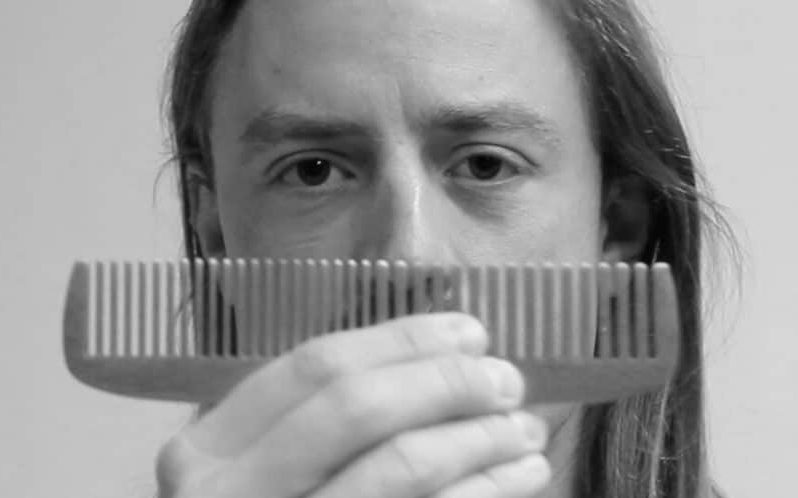
Summary
Hair loss is normal.
Everyone loses between 50 and 250 hairs a day as part of the grow-and-shed phase healthy hair goes through.
The majority of men will experience Male Pattern Baldness at some stage in their lives, which usually manifests in a receding hairline or a thinning crown. This type of hair loss is less about the number of hairs lost and more about what you can observe over time.
In rare circumstances, a variety of other reasons such as hormonal imbalances or skin diseases can lead to irregular, often sudden hair loss. If you have chunks of hair falling out or spot quickly growing bald spots, seek medical advice.
But wait – what if you didn’t have to worry about all you just read? See what you’d look like bald! You might just like it and decide to join a club of proud guys who worry much less about what’s happening on their heads. .

